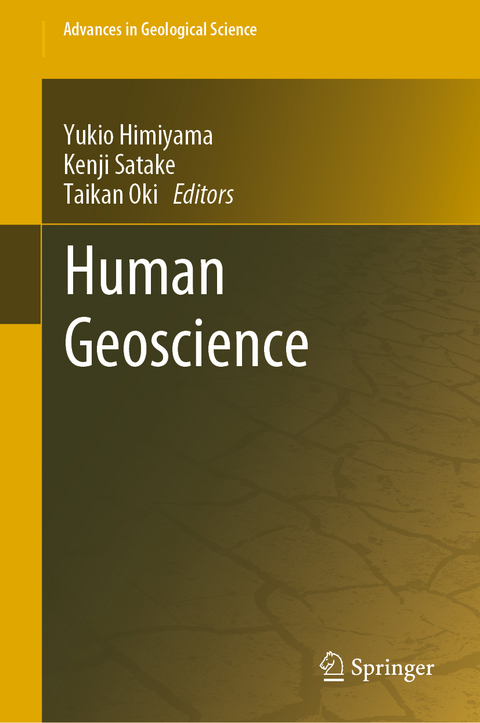
Human Geoscience
Springer Verlag, Singapore
978-981-329-223-9 (ISBN)
Yukio HimiyamaYukio Himiyama is an emeritus professor of the Hokkaido University of Education, Japan. He taught at this university from 1980 until 2015 after receiving his MSc in physics at UCLA and Tohoku University, and his PhD in geography at King’s College London. With this background and in this vocational environment, he has written and edited numerous articles and books in geography and geography education, sustainability sciences and sustainability education, land use/cover change, disasters, lifelong learning, and other related fields. He has been active in Science Council of Japan and the Japan Geoscience Union for more than a decade, assuming several key posts, and has nurtured his broad interdisciplinary insight which helped him to develop a new academic discipline for sustainability such as human geoscience. He is currently the president of the International Geographical Union (IGU). Kenji Satake Kenji Satake is a professor and thedirector of the Earthquake Research Institute, The University of Tokyo. His research interests are giant earthquakes and tsunamis in the world, for which he uses geophysical, geological, and historical approaches. He was the chair of the International Union of Geodesy and Geophysics (IUGG) Tsunami Commission from 2003 to 2011, during which period the 2004 Indian Ocean and 2011 Tohoku tsunamis occurred. He is a fellow of the American Geophysical Union and currently a vice president of the International Association of Seismology and the Earth’s Interior (IASPEI). He is the editor-in-chief of Geoscience Letters, the official journal of the Asia and Oceania Geosciences Society, for which he served as president from 2012 to 2014. Taikan Oki Professor Taikan Oki’s research specializes in global hydrology and the sustainability of world water resources, including virtual water trade and water footprints. He was one of the coordinating lead authors for thechapter “Freshwater Resources” in the Intergovernmental Panel on Climate Change (IPCC) Fifth Assessment Report (AR5). He obtained his BEng and PhD degrees at The University of Tokyo. He also received qualification as a weather forecaster. He became a professor at The University of Tokyo in 2006. He is the senior vice-rector of United Nations University and has been an assistant secretary-general at United Nations since 2016. He is the recipient of many awards, including the Biwako Prize for Ecology in 2011 and the Japan Academy Medal in 2008. He became the first Japanese American Geophysical Union Fellow in its Hydrology Section in 2014.
Part I Introduction
1 Emergence of Human GeoscienceYukio Himiyama
Part II Earth Surface Realms
2 Atmosphere - the Gaseous Realm which supports Human LifeAkio Kitoh
3 Lithosphere - the Solid Realm which supports Human LifeTakashi Oguchi
4 Hydrosphere - the Water Realm which supports Human Life Taikan Oki
5 Human Sphere - the Earth Surface Realm created by HumanYukio Himiyama
Part III Natural Resources and Society
6 World Land Resources at StakeYukio Himiyama
7 World Soil Resources at StakeTsuyoshi Miyazaki and Chihiro Kato
8 World Water Resources at StakeTaikan Oki
Part IV Natural Hazards and Society
9 Active Fault and earthquake disastersYasuhiro Suzuki
10 Earthquake Disasters and Government CommitteesKenji Satake
11 Tsunami Science and Disaster PreventionKenji Satake
12 Volcanic Eruption and Human GeoscienceSetsuya Nakada
13 The 2014 Eruption of Mt. Ontake Volcano and its DisasterKoshun Yamaoka
14 Mud Volcanoes and Human GeoscienceKazuhiro Tanaka, Keiji Asano, Tomokazu Ishihara, Masatoshi Watanabe, Dai Komatsubara, Natsuko Kasirajima, Shingo Tokuyasu, Toshikazu Shinya and Koichi Suzuki
15 Land Use Change and Flood Risk Transformation in Urban AreaShigeko Haruyama
16 Landslides and Human GeoscienceMasahiro Chigira
17 Nuclear Disaster and Human GeoscienceAkihiko Kondoh and Akira Hama
Part V Global Environmental Problems
18 Population Dynamics and the EnvironmentYoshiki Wakabayashi
19 Urbanization: Concept, Mechanism and Global ImplicationsYuji Murayama and Ronald C. Estoque
20 Climate Change We Human are Responsible forAkio Kitoh
21 Anthropogenic Lead Pollution in the OceanToshitaka Gamo
Part VI Global Sustainability Programmes and Human Geoscience
22 Education for a Sustainable SocietyYoshiyasu Ida
23 Geo-information Sharing for Sustainable Development of Human SocietyEikichi Tsukuda, Shinji Takarada, Koki Iwao and Joel Bandibas
24 Global Sustainability Programmes and Human GeoscienceYukio Himiyama
| Erscheinungsdatum | 04.10.2019 |
|---|---|
| Reihe/Serie | Advances in Geological Science |
| Zusatzinfo | 105 Illustrations, color; 37 Illustrations, black and white; XII, 339 p. 142 illus., 105 illus. in color. |
| Verlagsort | Singapore |
| Sprache | englisch |
| Maße | 155 x 235 mm |
| Themenwelt | Naturwissenschaften ► Biologie ► Ökologie / Naturschutz |
| Naturwissenschaften ► Geowissenschaften ► Geologie | |
| ISBN-10 | 981-329-223-7 / 9813292237 |
| ISBN-13 | 978-981-329-223-9 / 9789813292239 |
| Zustand | Neuware |
| Haben Sie eine Frage zum Produkt? |
aus dem Bereich


